The Royal Botanic Gardens at Kew are situated between Kew and Richmond upon Thames in southwest London, Great Britain. Kew Gardens, formally the Royal Botanic Gardens at Kew, is the site of a former royal estate. The original botanical gardens were created in the 1750s by Augusta of Saxe-Gotha, Princess of Wales, who lived in Kew Palace. Her son, King George III, inherited the Kew Estate and joined it with the royal estate in Richmond, and the two gardens were combined to form the Royal Botanic Gardens at Kew. From the late 1760s, the influential English landscape designer Lancelot 'Capability' Brown re-designed Kew Gardens for King George III. The gardens were opened to the public in 1841. In the beginning of the 20th century, Kew Gardens was enlarged and extended to the present size of 120 hectares. The collection of plants include specimens from all over the world. The Palm House was built between 1845 and 1848, it is the most important building in the Royal Botanic Gardens at Kew. The Temperate House is the largest Victorian glasshouse in the world, after many years of restoration work, it was reopened in may 2018. Other important features in Kew are the Great Pagoda, the Princess of Wales Conservatory and the Treetop Walkway. The Royal Botanic Gardens at Kew gained the status as a UNESCO World Heritage in 2003.
www.werelderfgoedfotos.nl © Copyright World Heritage Photos Classic Car Road Trip
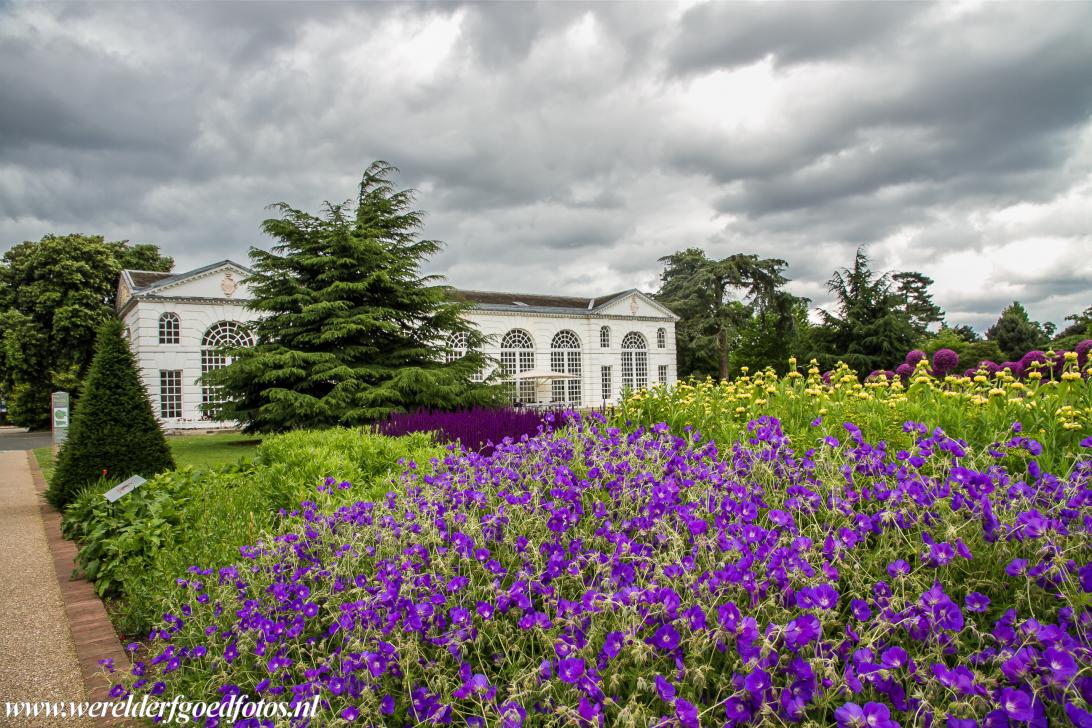
Royal Botanic Gardens, Kew: The Orangery is situated on the Broad Walk. The Broad Walk leads from the main gate towards the Palm House. The Orangery of Kew Gardens was built in 1761, it is a beautiful example of Georgian architecture. Today, the Orangery is a restaurant. The Royal Botanic Gardens at Kew gained the status as a UNESCO World Heritage in 2003.

Royal Botanic Gardens, Kew: The Orangery is situated on the Broad Walk. The Broad Walk leads from the main gate towards the Palm House. The Orangery of Kew Gardens was built in 1761, it is a beautiful example of Georgian architecture. Today, the Orangery is a restaurant. The Royal Botanic Gardens at Kew gained the status as a UNESCO World Heritage in 2003.

Royal Botanic Gardens, Kew: The amazing Palm House at Kew is the most important building in the gardens. The Palm House was built between 1845-1848 to create a rainforest environment. The Palm House was the first large-scale structurale use of wrought iron and it is considered the most important surviving Victorian glass and iron structure in the world.
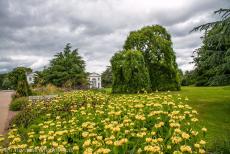
Royal Botanic Gardens, Kew: The border along the Broad Walk, the Orangery in the background. Kew Gardens contains over fifty thousand varieties of plants from all parts of the world, there is also a Herbarium of more than seven million specimens. The Herbarium collection of Kew is one the largest in the world. The Herbarium building is a former 18th century hunting lodge.

Royal Botanic Gardens, Kew: The Hive is situated in a fragrant wildflower meadow. The Hive was designed to highlight the importance of bees. The Hive is 17 metres tall and weighs 40 tons. The Hive is made of 170,000 pieces of aluminium and inside the open structure, 1000 LED lights light up in response to the activity of the bees in the nearby real-life beehive.
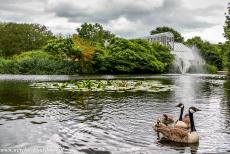
Royal Botanic Gardens, Kew: Canada geese with their goslings swimming in a pond. Behind the pond lies one of the Victorian glasshouses of Kew. Two important Victorian glasshouses in Kew Gardens are the Palm House and the Temperate House, the largest Victorian glasshouse in the world. During our visit, the Temperate House was closed for restoration works.
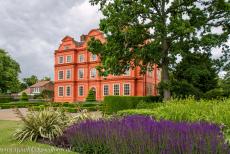
Royal Botanical Gardens, Kew: Kew Palace was formerly known as the Dutch House. The palace was built in the supposedly Dutch style in 1631. Kew Gardens is the site of a former royal estate. The gardens were created in 1759 for Augusta, Princess of Wales, who lived at Kew Palace. The gardens were opened to the public in 1841.

Royal Botanical Gardens, Kew: Kew Gardens is situated close to London Heathrow Airport. The botanical gardens are located right under the flight paths of the airport. During our visit, a huge plane flew low overhead almost every two minutes and we could smell the kerosene. The Kew Gardens were inscribed on the UNESCO World Heritage List in 2003.
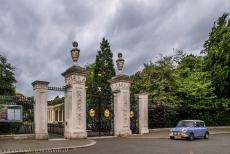
Royal Botanical Gardens at Kew: A classic Mini in front of the Main Gate of Kew Gardens. The gate was built in 1848 and is the northern entrance to Kew Gardens. In 2012, the Main Gate has been renamed Elizabeth Gate to commemorate the Diamond Jubilee of Queen Elizabeth II. Just behind the gate lies the Nash Conservatory.
